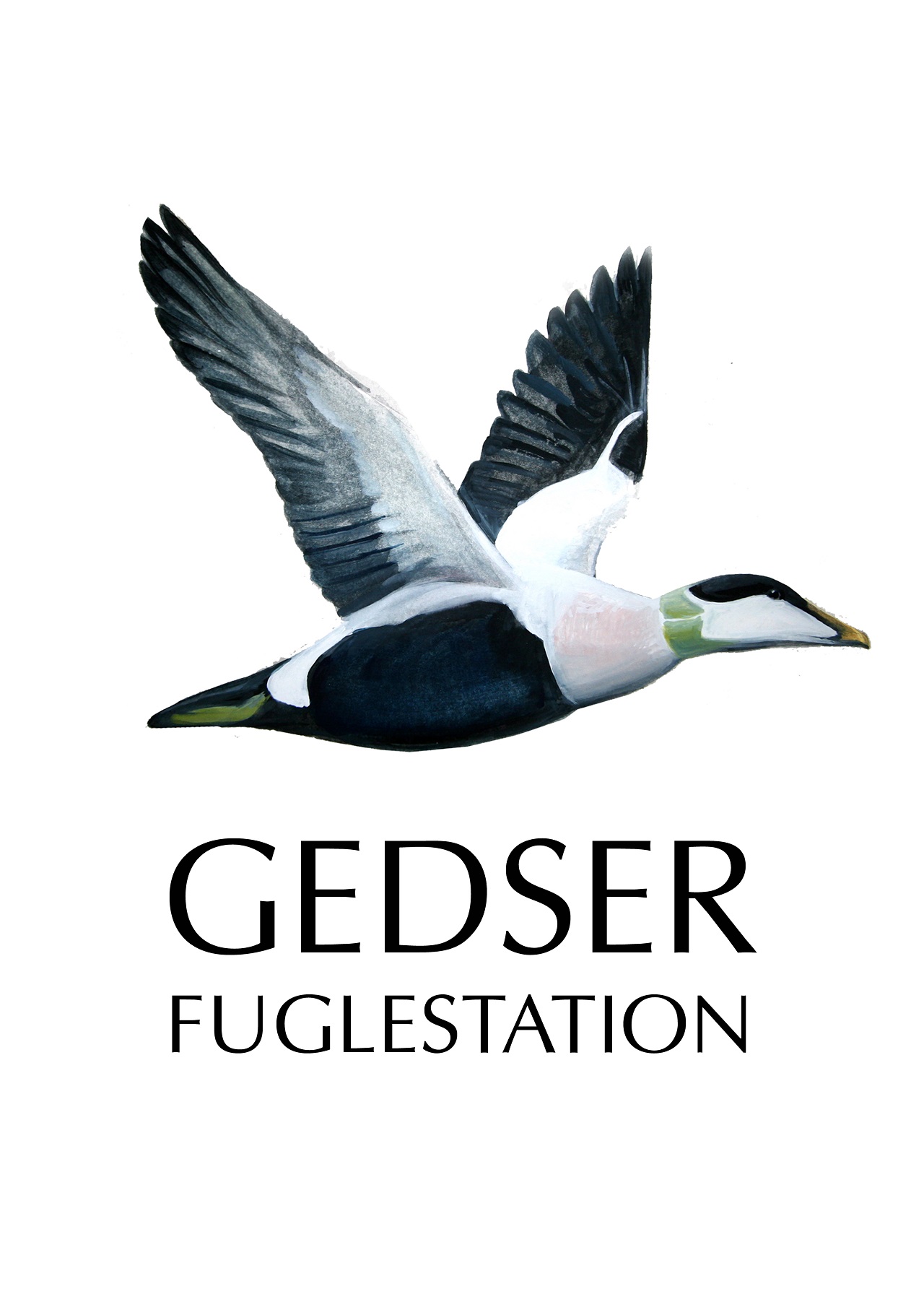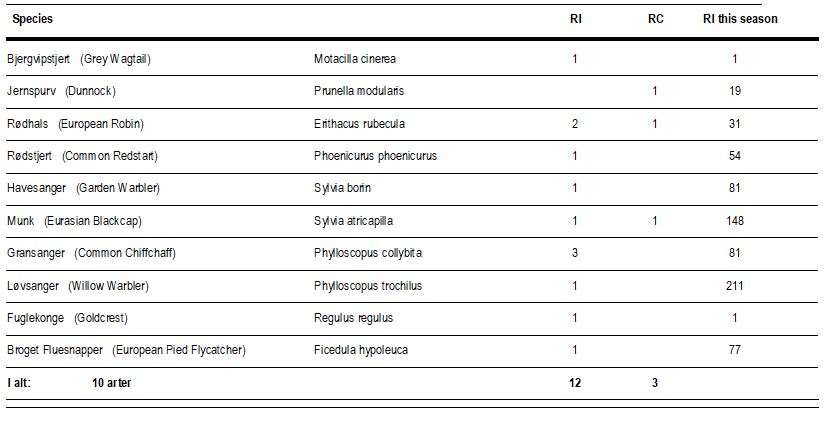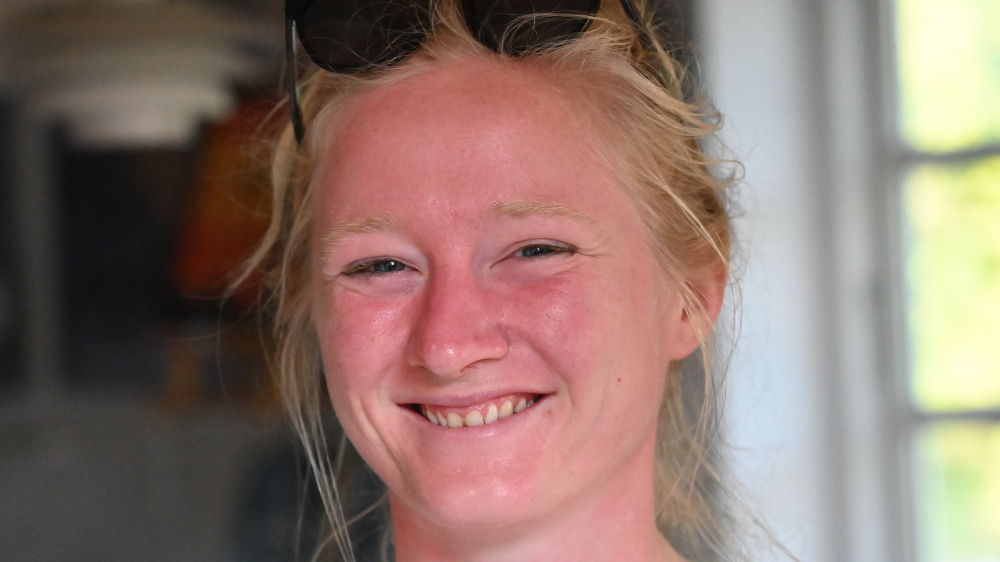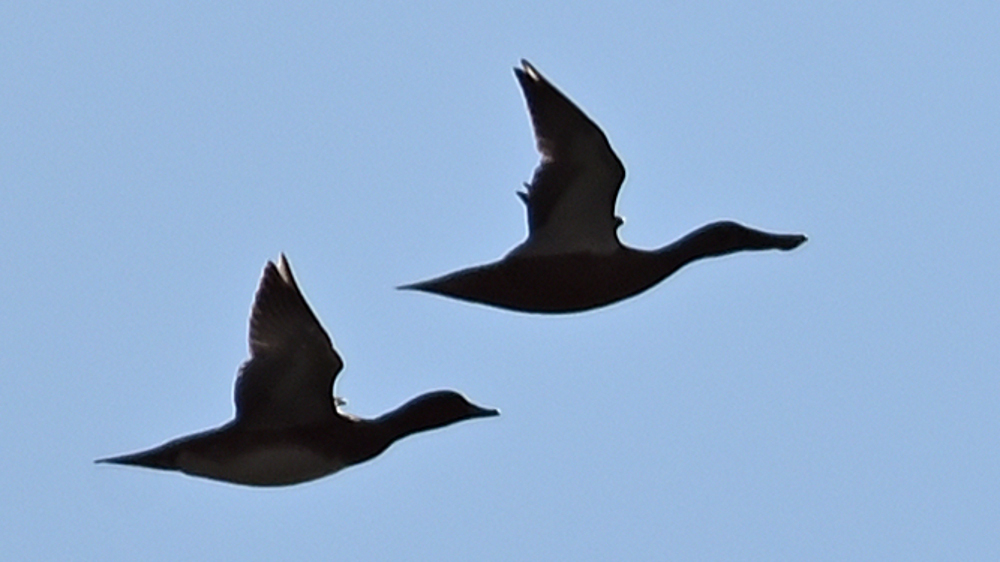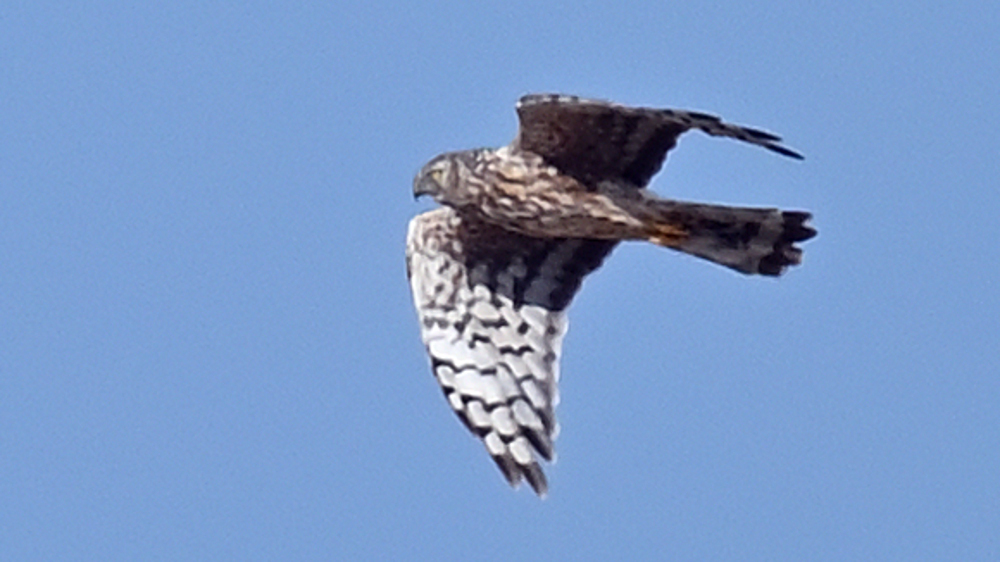Gedser Fuglestation Blog
Her på Gedser Fuglestations blog bringes korte nyheder i dagbogsformat om hændelser på fuglestationen.
Se indlæg fra måned: jan. (10)feb. (18)mar. (31)apr. (26)maj (31)juni (30)juli (23)aug. (31)sept. (30)okt. (31)nov. (30)dec. (20)
Lots of wind from the west
The ringing:
The morning started windy and this continued for the rest of the day, but in the garden it was mostly sheltered so we could still open most nets. But there was not much to do for us, just twelve new birds in the nets, one nice species that is not caught that often was a juvenile Grey Wagtail “Bjergvipstjert”. But that gave us time for the moth between the rounds which was also nice, although more birds would be appreciated.
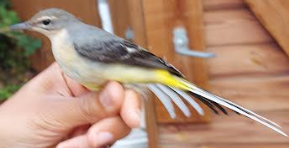
Grey Wagtail "Bjergvipstjert"
The moths:
Not many more moth species than birds in the traps, but there was not so much to expect as it was a quite windy night. But some nice ones and both Robert and I had new species.
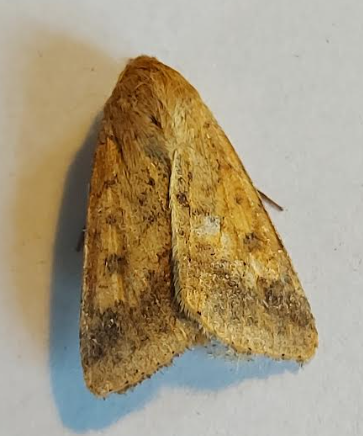
Helicoverpa armigera "Kriger Træk Ugle"
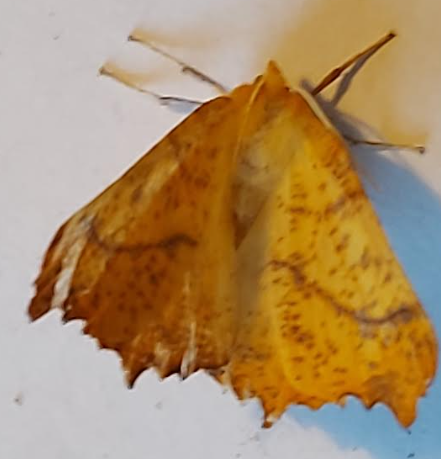
Ennomos autumnaria "Stor Tandmåler"
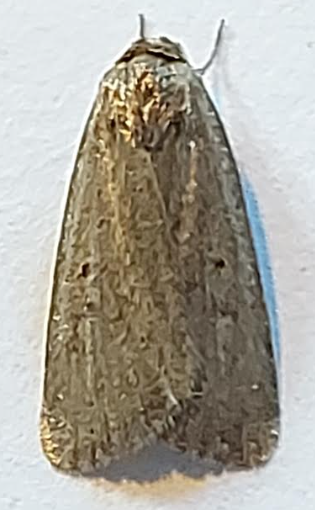
Athetis lepigone
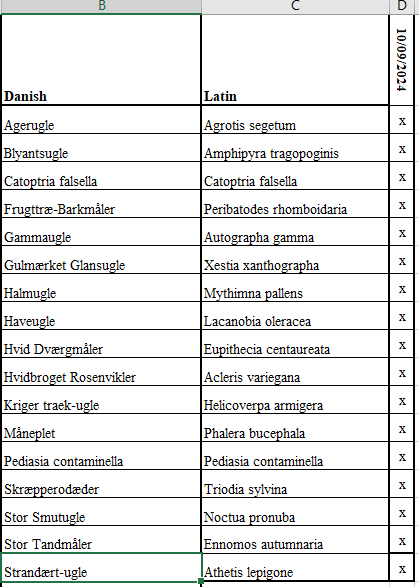
Migration Counts at Gedser Odde
Lara W
First, a quick apology for not updating the blog yesterday. Migration counts were minimal due to low visibility caused by heavy rain. Approximately 300 birds were spotted, most of which appeared in the final 40 minutes of standard time as the rain thankfully eased up. Several larger flocks of Common scoter/Sortand, interspersed with a few Sandwich tern/Splitterne (Thalasseus sandvicensis), and Wigeon/Pibeand (Anas Penelope), were seen far out on the horizon. Higher numbers of Mute Swan/Knopsvane (Cygnus olor), were counted than for the past week, totalling 83 individuals.
On to today’s count…
Seabird migration was surprisingly low, considering the relatively clear skies and lack of precipitation. Only 4 male Eider/Ederfugl (Somateria mollissima) were seen, all in eclipse plumage. In case the reader is unaware, the eclipse plumage is for cryptic purposes, making them less visible to predators during the period where the birds are in moult. Eiders, like several duck species, undergo full wing moult after breeding, replacing all their flight feathers at once which renders them essentially flightless until the feathers regrow. These darker “eclipse” feathers later abrade (wear down) into the signature white the species is known for.
Raptor numbers, on the other hand, were high, with 9 Honey Buzzard/Hvepsevåge (Pernis apivorus), 115 Sparrowhawk/Spurvehøg (Accipiter nisus), 7 Marsh Harrier/Rørhøg (Circus aeruginosus), 2 Merlin/Dværgfalk (Falco columbarius), and 3 Kestrel/Tårnfalk (Falco tinnunculus), counted flying out over the cliffs. At times it was difficult to know where to look, and at one point I was so focused on the Honey Buzzard overhead I almost missed the Sparrowhawk that passed within a metre of my face! Two birds not migrating, but which appeared over the fields to the north, deserve mention – a stunning Red Kite/Rød Glente (Milvus milvus), bedecked in a suit of russet and gold, and a juvenile White-tailed eagle/Havørn (Haliaeetus albicilla). The eagle made his sedate way across the fields and up above the station before moving away towards Gedser town, seemingly unphased by the small flock of Hooded Crow/Gråkrage (Corvus cornix) who attempted to mob him.
Five hours of birding wasn’t enough, so Gert and I went for a wander up to the nature reserve at Bøtø Nor. This was my first visit here, and we went to a couple of the hides (dubbed Fugletårn (“bird tower”) in Danish, I have to say this is a far better name for them than the rather boring name of “hide” in English!). The site comprises some 200 acres, and the Fugletårn look out onto a lake bordered by tall rushes and grassland, with a small wood to the south. A number of different duck and wader species were present, including Shoveler/Skeand (Anas clypeata), Gadwall/Knarand (Anas strepera), and Teal/Krikand (Anas crecca). A large mixed-age flock of Lapwing/Vibe (Vanellus vanellus) dominated the water, with several energetic Ruff/Brushane (Calidris pugnax) quick-stepping through the heftier birds in their search for small crustaceans, fish and molluscs within the mud below the water. One particular individual seemed a little more intrepid than the others, having waded in so the water level was at chest height, and therefore having to take some rather more violent steps to move effectively.
This peaceful but busy scene was periodically interrupted by the appearance of a juvenile White-tailed eagle, when all the waterbirds would erupt upwards, swirling and vortexing in the sky until this large predator had once more soared away on lazy wingbeats. A kestrel also provided me distraction, perching atop a small log in the grasslands in the sun for a little while. At one point, she must have spotted an insect, and with great intent, giving a distinct “hunting cat” impression, she scrambled after it, her high-stepping long legs giving a rather comical attitude to the endeavour.
At the final Fugletårn, two adult and one juvenile Crane/Trane (Grus grus) were seen grazing in the tall grasses, with several Great white egret/Sølvhejre (Ardea alba) and Grey Heron/Fiskehejre (Ardea cinerea) nearby. We arrived just in time to see them – after only a few minutes they flew off to join 4 other cranes who circled above the area for a while before disappearing south. Overall, a wonderful birding experience!
Robert Luttik, Lara Winsloe, Hanelie Sidhu
A day with a lot of rain at the wrong moment
It did not look good for catching birds, the forecast was terrible. But the first load of rain did not touch Gedser Odde, so I opened at six some nets to stay at the safe side for when the rain would start and it did at 7.30 and I closed the nets. Caught 9 birds (4 species see table) The highlight was a Tree Pipit (Skovpiber).

I had also only two moth traps out and caught a few. In this case the nicest one was a Rødt Ordensbånd.
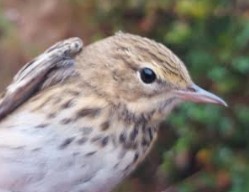
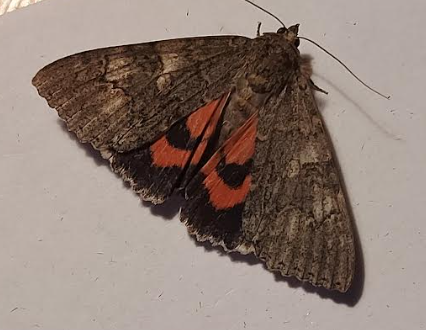
At this moment we are with three people at the station (Hanelie, Lara and myself). So it is time that the birds arrive.
The day after the moth evening
Last evening it was an open day for people to see some moths and listen to bats. I did not attend the bat exursion but they saw and heard quite a few bats. Moth were also there. We had some mercury lamps and they attracted a reasonable amount of moths and other insects The highlight was a Snerlesvæmer (Convolvulus Hawkmoth) and in the morning there were even three present and a moth named Takleniet Græsugle in English the Delicate Moth. This is a small yellow migratory moth from the south.
I only caught 17 birds (16 new and one recapture). The highlight for me was the yound male Redstart (Rødstjert).
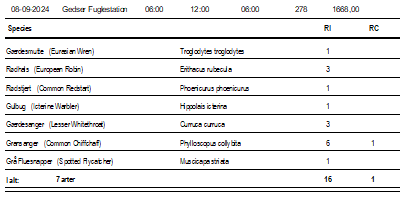
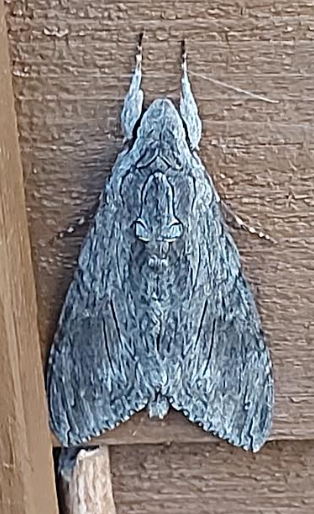
Snerlesvæmer (Convolvulus Hawkmoth)
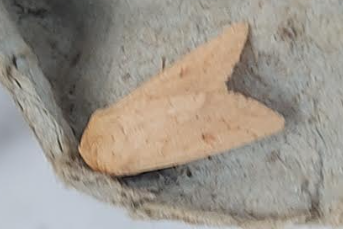
Takleniet Græsugle (The delicate moth)

Migration counts at Gedser Odde
by Lara W
Overall numbers of seabird migration took a slight dip today, although several species not seen on previous days this past week were spotted, including Black Tern/Sortterne and Scaup/Bjergand. Sandwich tern/Splitterne continue to whizz by on their powerful angular wings, with a few Little gull/Dværgmåge interspersed among them – from a distance looking vaguely similar to the tern, but with slightly rounder wings and clearly smaller size. Both scoter species (Common scoter/Sortand, Velvet Scoter/Fløjlsand) came by the point in several larger flocks of up to 35 at a time. These birds have a much chubbier and more compact appearance to many of the other duck species which pass by, seemingly much smaller than the Wigeon/Pibeand, despite being of similar length. Flying generally in single species flocks, the leaders of the group are often bunched up together, with the rest straggling along behind either in single file or several intermingling lines.
Raptor numbers continued to grow, with 8 Kestrel/Tårnfalk, 2 Merlin/Dværgfalk, 2 Hobby/Lærkefalk, plus 102 Sparrowhawk/Spurvehøg streaming past, often in groups of 3-5, lining up rather like airplanes on an overcrowded runway. 3 Honey Buzzard/Hvepsevåge were also seen, in deep chocolate brown plumage, their large yellow cere (the soft tissue surrounding the nostrils sitting atop the bill) clearly visible against the dark plumage. A single Red Kite/Rød Glente provided excitement too, gliding above the fields and trees towards us, the deeply forked tail constantly twisting and turning in the light breeze.
Passerines continued in a steady flow over the cliffs all morning, with over 300 Barn Swallow/Landsvale, 88 Wagtails (both Yellow/Gul Vipstjert and White/Hvid Vipstjert), and 54 Tree Pipit/Skovpiber counted. 2 Swift/Mursejler made a special appearance towards late morning amongst a flock of other hirundines, the boomerang-crescent shape of their wings clearly marking them out as different from the rest.
Today was my first day monitoring migration without official guidance, and I will admit to being a touch nervous. However, I was greeted at the point by the fantastic LAH who has been birding at Gedser for around 16 years. The varying calls of Tree pipits, and both white and yellow wagtails, were pointed out, along with the wing shape and flight action of different small raptors. Much of the birding I have done before, which I am sure many amateur birders will be able to relate to, relies on colour patterns and general shape and size of a bird to reach identification. Recognising calls and behaviour adds a whole other dimension to the process. My thanks to LAH for taking me under his wing as it were.
In total, 1052 individual birds were counted migrating, with 38 species represented…I look forward to seeing what tomorrow will bring!
Robert Luttik, Lara Winsloe
Masser af Spurvehøge og Lærkefalke
Ringmærkningen: Chris Sharp er taget hjem til Tyskland efter lørdagens ringmærkning og bliver afløst af en anden af fuglestationens faste folk, Robert Luttik, fra søndag morgen.
Trækket på Odden: Vejret er stadig det samme gennem snart mange dage med let vind fra østlige retninger og masser af sol. Det er dejlige arbejdsforhold for observatørerne fra fuglestaitonen og andre, som kommer for at opleve trækket, men det giver ikke nogen stor variation i trækket og ikke så mange fugle – og så alligevel. Trækket af rovfugle er taget til gennem de seneste dage, og lørdag nåede vi op på 85 Spurvehøge (Accipiter nisus) i standardtiden. Trækket fortsatte hen over dagen, og Louis A. Hansen fra Gedser sendte sidst på eftermiddagen en sms om mindst 220 Spurvehøge og 21 Lærkefalke (Falco subbuteo) – det tredjestørste antal registreret ved Gedser Odde.
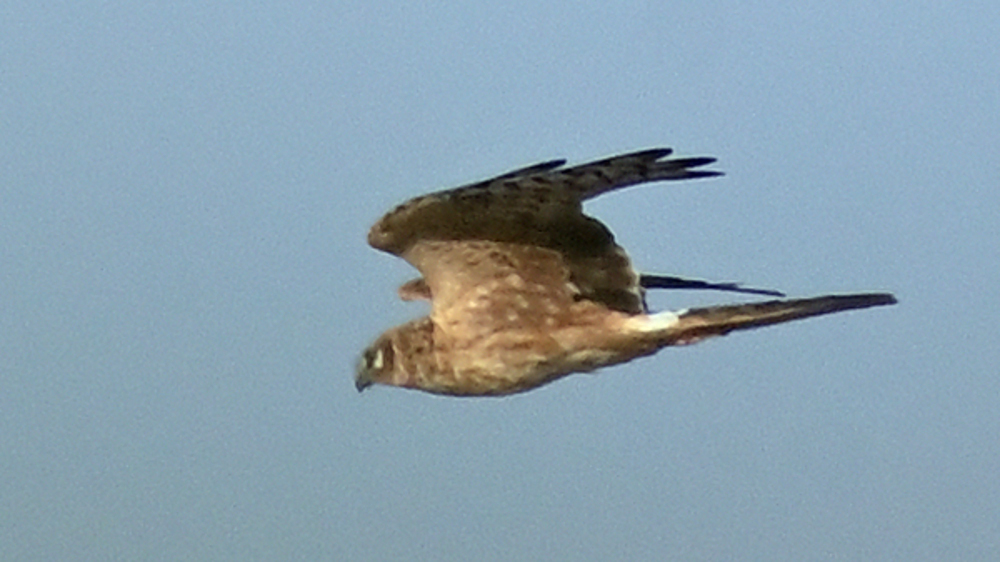
Læg dertil en Steppehøg (Circus macrourus) og en flot mørk ung (1k, første kalenderår) Hvepsevåge (Pernis apivorus).

På havet var der ikke meget trafik, men dog lidt flokke af svømmeænder og Sortænder (Melanitta nigra) samt lidt hanner i et par småflokke af Ederfugle (Somateria mollissima)
Længere bliver rapporten om trækket ikke i dag. Det er blevet sent, og vi har et aftenarrangement om nattens insekter og lyde på fuglestationen. Jeg er væk de næste tre uger til blandt andet en konference om Havørne (Haliaeetus albicilla) i Kroatien, men der er ikke noget at være bekymret for. Trækket bliver dækket af Lara Winsloe og andre på fuglestationen i samarbejde med de lokale fuglefolk. Det bliver helt sikkert fint, og hvis det kniber med de engelske tekster kan man altid prøve med Google Oversæt. Vi har den regel på fuglestationen, at navnene på arterne altid skal skrives på dansk og engelsk eller med det videnskabelige navn første gang, de bliver nævnt i et indlæg på bloggen.
Se alle dagens observartioner fra Gedser Odde in DOFbasen.
Folk på stationen: Lara Winsloe, Robert Luttik, Chris Sharp, Tina og Mads Elley, Gert Juul Jeppesen, Hans Lind, Ole Friis Larsen.
Moments
And so it comes to the moment where this is my last blog for this visit. Reflection on the word moment perhaps is a useful convergence for ideas for the time spent here. As ever it has been enjoyable and the enjoyment is a composite of numerous points, special encounters that contribute to spending time at this special place.
A couple from Roskilde, who I've now met several times, say they like coming here because the point, the observatory, has a special atmosphere. They are right but I think that speciality varies from person to person, and time to time.
The light each morning when opening the nets has a sublime quality that eases one into the day, and each day is different. It can be moonlight reflecting off the sea, sometimes silver, sometimes blindingly brilliant, always magical in its ephemeral nature. The calls of birds that have arrived overnight: tac-tacing blackcaps, tic-ticking robins wrapped up in the calls of gulls and terns. The heady aroma, a mix of meadow, tree and sea. Then the wind, the breeze passing through the trees and the light creating soft dancing shadows with the leaves. Magical, ever-changing, a dynamic constant.
So this evening as I reflect on this beauty of nature I am reminded of a poem by the poet Kathleen Raine; here is the final verse of her poem, The Moment, it encapsulates my rich Gedser experience:
The sun that rose / From the sea this morning / Will never return, / For the broadcast light / That brightens the leaves / And glances on water / Will travel tonight / On its long journey / Out of the universe, / Never this sun, / This world, and never / Again this watcher.
Thank you Gedser for the refreshment and re-invigoration that you give me, a watcher, and to many others too!
And so to the more mundane, the ringing. Another low number day but hey who says that you have a divine right to large numbers.
Sparrowhawk/Spuvehog 1/-; Dunnock/Jernspurv 1/-, Robin/Rædhals 5/-; Garden Warbler/Havesanger 1/-; Blackcap/Munk 1/1; Willow Warbler/Løvsanger -/1; Spotted Flycatcher/Grå Fluesnapper 1/-; Pied Flycatcher 1/-. Total 13 (11/2)
Migration at Odden: Today was another blustery morning at the cape, with over 1100 birds counted migrating south for the winter. Most of these were ducks (Wigeon/Pibeand, Teal/Krikand, Pintail/Spidsand, Common scoter/Sortand, Velvet Scoter/Fløjlsand), whizzing across the skies in flocks up to 50 strong, often just above the choppy waves, sometimes cruising high above.
Several Great white egrets/Sølvhejre were spotted too, one flying directly above our heads (see photo below). The highlight was definitely five Arctic skua/Almindelig Kjove, the first two of which came within a couple hundred metres of our vantage point. On first impression, their silhouette and flight pattern reminds one of a tern: turning swiftly into the winds, flaring their wings out before tucking in for a steep dive, but the overall shape is rather larger and, of course, a darker steel grey colour against the waves. Whipping quickly in and out of sight, these birds were definitely something out of the ordinary.
From the south behind us, rising out of the golden fields, around a hundred birds of prey came tumbling towards the cliffs. 75 Sparrowhawk/Spurvehøg, along with 3 Hobby/Lærkefalk, and 2 Marsh Harrier/Rørhøg were spotted, although a White-tailed eagle/Havørn provided particular excitement (although that may have just been for me, given they are so rare in my homeland of the UK). With a max wingspan of 240cm, this bird dwarfs the tiny sparrowhawk by almost 5 times in length alone, soaring unconcernedly above the trees behind us. A wonderful sight indeed.
This afternoon the team went on a birding outing to the wetlands at Kaløgrå Fugletårn, an old water treatment centre turned nature reserve to the north of Lolland Island. We highly recommend to anyone who has not been! A relatively large site that is now almost completely grown over with rushes and grasses, surrounding several pans which, due to the recent lack of rain, are now only just covered in water.
The reserve looks out onto the sea. There is a hide set up which provides views across most of the area, otherwise grass tracks provide access. Several hundred Greylag geese/Grågås, Mute swan/Knopsvane, and Black-headed gulls/Hættemåge made up the bulk of the individuals, along with a number of wader species (including Curlew/Storspove, and Dunlin/Alminjelig Ryle).
A single Caspian tern/Rotverne – the largest tern species in the world – was spotted preening amidst the smaller gulls and waders. The seemingly overly-large bright red bill, coupled with its full black cap, made this spectacular bird stand out starkly from the surrounding shades of white, grey, and brown. Other species of note include Crane/Trane, Avocet/Klyde, and Garganey/Atlingand.

See all the day’s observations from Gedser Odde in DOFbasen.
People at the observatory: Lara Winsloe, Chris Sharp, Ole Friis Larsen.
Fair Stood The Wind
According to Shakespeare the wind stood fair for France so Henry V's army could cross the English Channel and seek battle with the French. Today the wind stood fair from the east making great billows in the nets which, unsurprisingly, the birds avoided. Indeed there were not many birds in the ringing garden. Though many passerines were seen flying over the garden towards Germany, and who knows, maybe onto France too.
Consequently the catch was small - ten birds of six species. Unfortunately that maybe the trend for the next few days.
Of note were the three Pied Flycatchers, two juveniles and one adult. The adult had completed wing moult but some tail feathers and tail coverts were still being replaced and it looked suspiciously like a female - will we ever know? Hopefully she will be re-trapped somewhere in her travels and we'll then find out.
Ringing totals:
Robin/Rødhals/1; Icterine Warbler -/1; Lesser Whitethroat/Gærdesanger-/2; Blackcap/Munk 2/-; Chiffchaff/Gransanger 1/-; Pied Flycatcher 3/-. Totals: 10 (7/3)
Migration observations at Gedser Odde: Hello, Lara here – the newest member of the team at Gedser Fuglestation. Today was my second day out on the migration counts at the southernmost tip of Denmark. The dramatic lightning storms of the previous day had abated, with a relatively strong wind blowing white caps on the waves below the point.
Never having had to identify birds several miles out, against the rising sun no less, is certainly a challenge, but luckily, I have some very good teachers in the resident migration expert Ole Friis Larsen and a couple of other birders who visit each morning to track migration, who are more than happy to point out birds I’ve not previously come across, and explain their identifying features.
Having previously relied on signs such as song, colour, habitat and movement patterns, abruptly switching to such “macro” indicators like size, shape, flight pattern and, if discernible, colour bars or blocks on the wings or belly is a real challenge.
Overall numbers were up by a couple of hundred from yesterday, with just over a thousand birds spotted passing by either above the waves to the south or rising up from behind us over the fields to launch themselves from land into the prevailing winds. Something like 30km separates the Gedser cape from the next landmass of Germany, and it really is a sight to behold watching various seabirds, passerines and raptors pass us by over the sea.
On a typical birding outing, I might have expected to see one or two small birds of prey, perhaps a Kestrel or Sparrowhawk. Today we saw 71 Sparrowhawks (Accipiter nisus. Spurvehøg), 3 Kestrel (Falco tinnunculus, Tårnfalk), a couple of Merlins (Falco columbarius, Dværgfalk) and a Red-footed falcon (Falco vespertinus, Aftenfalk), the latter producing a rush for binoculars or cameras and much gesticulating amongst the birders present. Even for seasoned birders, it seems, this bird is something special. Watching it glide, seemingly unconcerned, above us, undulating in the wind whipping up from the cliffs, was a beautiful moment indeed.
Further out from the shore (often much further out), several hundred Wigeon (Anas Penelope, Pibeand), Teal (Anas crecca, Krikand), Pintail ducks (Anas acuta, Spidsand), Common and even a few Velvet Scoter (Melanitta nigra, Sortand, and Melanitta fusca, Fløjlsand) flew rapidly past, helped along by the fast winds. Two Arctic skuas (Sterorarius parasiticus, Almindelig Kjove) were spotted far out on the horizon, along with several Common and Sandwich terns (Sterna hirundo, Landsvale, and Thalasseus sandvicensis, Splitterne). The terns certainly hold a particular captivation, in their rapid plummets to the waters’ surface, emerging soon after their dive – with or without a fish – for a quick whole-body shake to be rid of excess moisture, before returning to their perambulations about the skies. Those individuals on active migration are clearly set apart from those simply foraging by the active directness of their flight patterns, far less ambulatory than their (for now) resident counterparts.
Of passerines, only a couple of species were noted departing – 174 Swallows (Hirundo rustica, Landsvale), 30 White wagtails (Motacilla alba, Hvid Vipstjert), and a single House martin (Delichon urbicum, Bysvale). It is truly astonishing to know that these small and fine-boned creatures will fly without rest for several hundred (if not thousands) of miles before touching land again. The small flock of Tree sparrows (Passer montanus, Skovspurv) that inhabit the shrubs around the point almost seemed to laugh at these intrepid travellers.
As a final note, I’d like to make special mention to the single Nutcracker (Nucifraga caryocatactes, Nøddekrige) who appeared near the end of our five-hour session this morning. He (or she) kept us all company yesterday too, leaving his perch atop the tree 75m from the cliffs no less than 12 times in three hours to test the winds and consider migrating….it did not seem like today was his day either, so perhaps we will see him again tomorrow and he will, finally, attempt the long journey south.
Sparrowhawk/Spurvehøg, Kestrel/Tårnfalk, Merlin/Dværgfalk, Red-footed falcon/Aftenfalk, Wigeon/Pibeand, Teal/Krikand, Pintail/Spidsand, Common scoter/Sortand, Velvet Scoter/Fløjlsand, Arctic skua/Almindelig Kjove, Common tern/Fjordterne, Sandwich tern/Splitterne, Swallow/Landsvale ,White wagtail/Hvid Vipstjert, House martin/Bysvale, Nutcracker/Nøddekrige
People at the station: Ole Friis Larsen, Chris Sharp, Lara Winsloe
Monastic Ringing
Awakening at the hour of vigils I could hear, to the backdrop of resounding thunder, a few birds calling, notably blackcap, robin and dunnock. The thunder was far-off but impressive in its resonance. During lauds (the time when light returns to earth) many blackcaps were uttering their morning prayers - more a tac-tac chant from many bushes, a suitable chant to accomany the opening of the nets. During prime their chants' intensity pleasing increased. Wonderfully this was followed by several of these warblers going into the nets in the first couple of net rounds.
Blackcap is a splendidly distinct member of the warbler family with the males sporting the eponymous black cap and the females a brown cap (have you ever wondered, like me, why the bird is not called browncap)? And when did man realise that these black and brown capped birds were the same species?
Munk, their Danish name, does not per-se refer directly to their head colouration but is refering to them as "monks". This reference to monks in repeated in several languages, Norwegian for instance. Monchsgrasmucke, their German name does not refer to them directly as monks. Monchsgrasmucke would roughly translate from old German into the "cowled warbler." The cowl refering to the dark cape that monks, and nuns, use as an outer garment on cold, rainy days.
Many of the blackcaps, like their monastic bretheren following prime, had breakfast. Today their breakfast of choice was many of remaining blackberries from the garden's brambles. The blackberries' passage through the birds' digestive system is fast. Hopefully this fast transit of the gut allows for sufficient time for the berries' sweet sugars to digested and absorbed. This sugar is then convered into fat, the fuel for their onward migration. Unforunately for the ringer the blackcaps don't seem to be very effective in digesting all of the berries. This apparent inefficiency results in the ringers' hands being frequently stained by the birds' purple coloured faeces. Ah well such are the joys of ringing!
Unsurprisingly blackcaps had a good presence in the day's ringing totals, which were as follows:
Dunnock/Jernspurv 2/-; Robin/Rødhals 1/1; Icterine Warbler/Gulbug 1/-; Lesser Whitethroat/Gærdesanger 11/-; Whtethroat/Tornsanger 4/1; Garden Warbler/Havesanger 1/-; Blackcap/Munk 17/-; Chiffchaff/Gransanger 6/-; Willow Warbler 3/-; Spotted Flycatcher/Grå Fluesnapper -/1. Total 49 (46/3)
People at the station: Ole Friss Larsen, Lara Winsloe and Chris Sharp
Ole will not be writing a blog tonight as he has had to go off to a meeting elsewhere in Denmark.
Quantity or Quality
Ringing: A quiet day with few passerines on the move, a situation not helped by a persistent east wind and bright sunshine illuminating some of the nets. Consequently the numbers of birds caught was low. Is that important? Is quantity important, or quality? In an ideal scenario you'd get both. But from this ringers' perspective it does not matter and I was perfectly happy with the quality in a fourteen bird catch. The quality essentially came in a sparrowhawk and two wood warblers.
At my home base sparrowhawks normally manage, frustratingly, to escape from the nets before I can get to them. Here there are two sparrowhawk nets set and the sparrowhawks' escape modus-operandi is thwarted. And so it was a juvenile male was in my hands and I spent sometime admiring its lethal talons, its breast feathers with their heart shaped patterning, and two intensely yellow eyes.
Yellow was a dominant feature of the Wood Warblers too. Their throats and the top of their breats were a vivid yellow that glaringly contrasted with their white bellies. The yellow and the white was so intense that it looked like they had been recently washed.
It*s worth mentioning that the Pied Flycatcher was an adult female hopefully migrating after a successful breeding season further north. I enjoyed looking at this individual too because at my German ringing site we ring many Pied Flycatchers in late spring but as soon as they have finished breeding they depart. Usually all thelocal birds have gone by mid-June and that is that for us until next year. So the question is: why do more northern populations leave later, is it really because they finish breeding later?
So the day's totals:
Sparrowhawk/Spurvehøg 1/-; Robin/Rodhals 2/-; Redstart/Rødstjert 1/-; Icterine Warbler/Gulbug -/1; Blackcap/Munk 4/-; Wood Warbler/Skovsanger 2/-; Pied Flycatcher/Broget Fluesnapper 1/-. Totals: 14 (13/1)
Trækket på Odden: Endnu en dag med solskin, lun luft og moderat vind fra øst, men alligevel ikke helt som mandag. Tirsdag gav flere svømmeænder på havruten, og fra land tog trækket af rovfugle tydeligt til, omend stadig i den lave ende med 10 Spurvehøge (Accipiter nisus). En enkelt Almindelig Kjove (Stercorarius parasiticus) blev dagens krydderi over havet. Desuden foregik det hele i godt selskab med erfarne lokalkendte folk. Først og fremmest tak til Morten Lisse for fem timers assistance, men også til fuglestationens it-specialist Anders Zuschlag og fuglestationsmedarbejder Gert Juul Jeppesen. Det er altid sjovere at være flere om at opleve og tælle fuglene end alene.
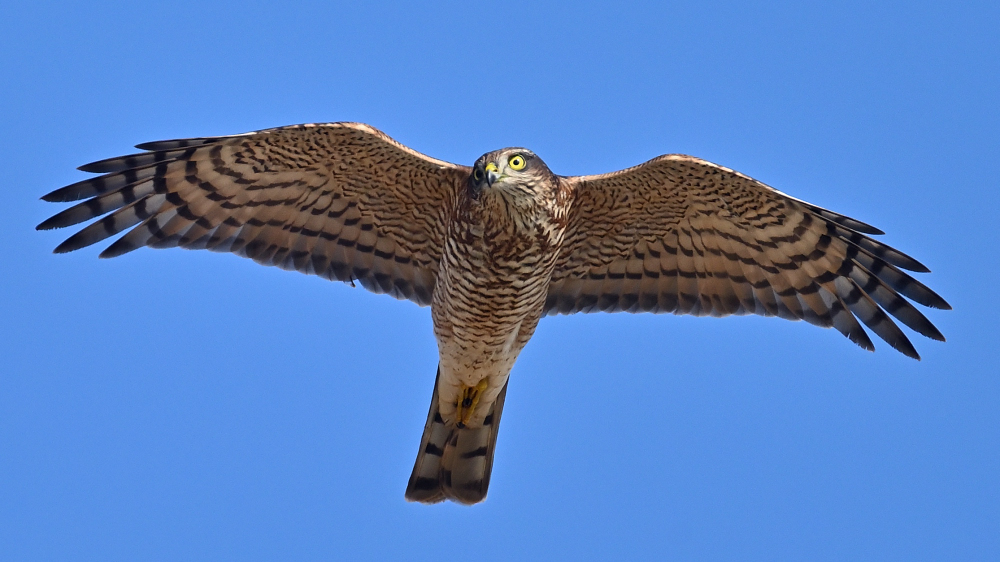
Kollegaerne ved Põõsaspea Neem havde igen en travl dag med tisusindvis af Sortænder (Melanitta nigra) og har nu på to dage registreret 130.000, som må være et sted mellem Estland og Gedser Odde, for vi havde knap så travlt med at tælle lidt over 600. Det er karakteristisk for efterårstrækket, at det aldrig er så hektisk som forårstrækket, når fuglene flyver op kap for at få de bedste ynglepladser. Sortænderne udgjorde alligevel over en tredjedel af tirsdagens lidt over 1.500 fugle på træk ved Odden.
Værd at bemærke var også over 250 Krikænder (Anas crecca) og lidt mere end 190 Pibeænder (Mareca penelope) med næsten 70 Skeænder (Spatula clypaeta) og lidt Spidsænder (Anas acuta) mixet ind i flokkene.
Ud over kjoven må 17 Sortterner (Chliconias niger) fordelt på to flokke høre til et af tirsdagens fine krydderier. Deres træk ebber hastigt ud gennem september, og enhver observation kan fra nu vise sig at være årets sidste.
Den ringmærkede Nøddekrige (Nucifraga caryocatactes) glimrede endnu en dag med sit fravær, men den tyske brevdue holdt stand for tredje dag i træk.
Se alle dagens observationer fra Gedser Odde i DOFbasen.
Nyt fra fuglestationen: Tirsdag ankom Lara Winsloe fra England for at hjælpe til med både ringmærkning og registrering af trækket ude på Odden gennem en stor del af efteråret.
Folk på fuglestationen: Lara Winsloe, Chris Sharp, Ole Friis Larsen.
Harey Leaves
The ringing: The Harey in the title is a deliberate spelling error. I started opening the nets in the dark but as a beautiful sunrise tinged the eastern sky I became aware of few birds in the garden but many hares. At one point there appeared to be one hare with three pairs of ears - must drink that coffee again!
In reality, it was three hares in an almost perfect line and consequently, their ears were also in a near perfect line. Given that the birds entering the nets was quite low it soon became a habit to watch for the hares as I wandered around the garden. A minimum estimate would be six individuals in the garden. And they were intriguing creatures to watch: twitching ears; sprawling with legs outstretched as they sunbathed - parasite control or hare relaxation? And eyes, so large and brown, staring at the world around them. They seemed to be in no hurry to hop away from me - that's a bit concerning as not all humans (and other animals too are not so hare friendly). It was particularly fascinating to watch them feed, it was not a clean bite action as I had always thought, it was more like watching a human sucking-up, then biting fettuccine.
And so to the birds. It would have been good if the birds had been as prolific in the nets as the leaves. After the colourful sunrise the wind intensity increased and blew many already dead leaves from the trees into the nets.
But there were some birds to ring. Possibly the most interesting one was a Wheatear - not a bird one associates with mist-nets in the garden. It was a colourful juvenile which I watched as I released it, its white rump disappearing towards Gedser Tip and hopefully onto Africa.
Ringing Numbers: Robin/Rødhals 3/-; Wheatear/Stenpikker 1/-; Icterine Warbler/Gulbug1/2; Lesser Whitethroat/Gærdesanger 5/-; Blackcap/Munk 4/2; Whitethroat/Gransanger2/-; Willow Warbler/Løvsanger 9/-. Totals: 29 (25/4)
So a day with many moments of watching nature - quite wonderful, and as I write these words I am reminded of a poem by the Welsh poet WH Davies, its first few lines go:
What is this life, if full of care,
We have no time to stand and stare.
No time to stand beneath the boughs
And stare as long as sheep and cows.
No time to see, when woods we pass,
Where squirrels hide their nuts in grass.
Two lines equals one verse. Several more verses then ending:
A poor life this if, full of care,
We have no time to stand and stare.
Hope you find some time to stand and stare at nature!
Trækket på Odden: Årets anden efterårsdag bød på fortsat let vind fra øst, masser af sol og lun luft, men betydeligt færre fugle på trækruterne end søndag. Det hele foregik heldigvis hele vejen igennem de fem standardtimer i godt selskab med de erfarne lokale fuglefolk Morten Lisse og Simon Vikstrøm, der dog kun kunne være med en times tid, før han skulle på job.
Lidt over 800 fugle af 28 arter var især et voldsomt fald i antallet af fugle i forhold til dagen før med samme type vejr, men trækket af nogle arter af svømmeænder viste en tiltagende trend med lidt over 80 Pibeænder (Mareca penelope) og 22 Spidsænder (Anas acuta). Mange kom i blandede flokke, hvor der også var Skeænder (Spatula clypeata) og Krikænder (Anas crecca). De flokke er en udfordring, der kræver hurtigt arbejde, når de passerer hastigt forbi som sorte silhuetter uden detaljer i modlyset – Spidsænderne er mere langstrakte end de andre, Skeænderne har større næb, Krikænderne er de mindste, og Pibeænderne er dem imellem.
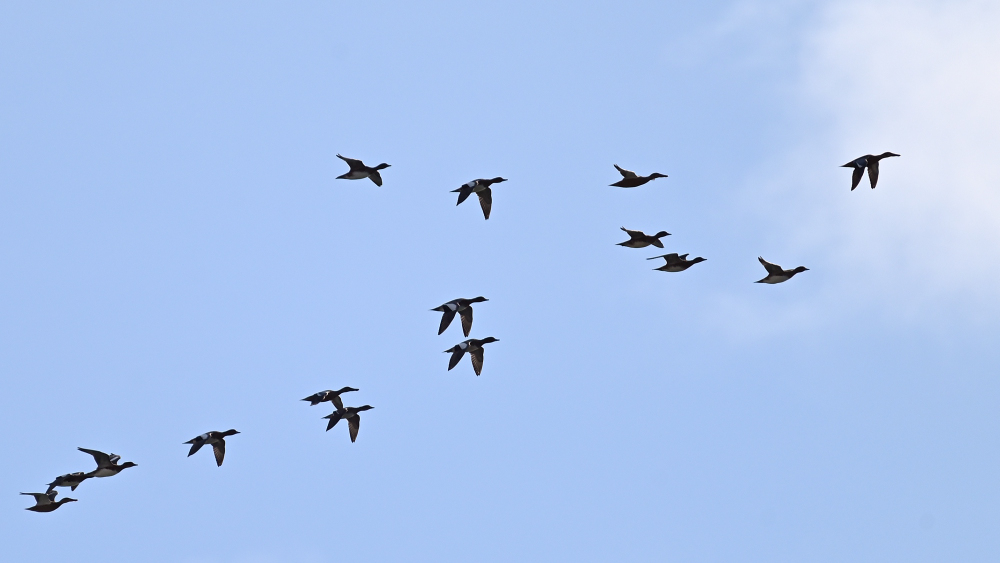
Sortænderne (Melanitta nigra) kom der bare lige under 140 af, men der må være rigtig mange på vej. Kollegerne ved Põõsaspea Neem i Estland havde mandag morgen nogle travle timer med at tælle 74.000 Sortænder og 4.800 Fløjlsænder (Melanitta fusca), som vi bare så tre af. Østersøen er ikke tømt for trækfugle endnu.
Til gengæld kom der lidt gang i trækket af rovfugle på Gedser Odde med lidt Spurvehøge (Accipiter nisus), et par Rørhøge (Circus aeroginosus), hvoraf en var en adult/voksen han, men først og fremmest havde vi glæde af to adulte/voksne hunner af Blå Kærhøg (Circus cyaneus), begge med tydelig gul iris i øjnene. Ifølge litteraturen får hunnerne først deres rent gule øjenfarve, når de er fem-syv år, så der var ikke meget at rafle om, selv om den ene havde en meget ren hvid bundfarve, og den anden var mere bruntonet på bryst og hals – det må være udtryk for den variation, som mange arter kan vise, uden at har noget med køn eller alder at gøre.
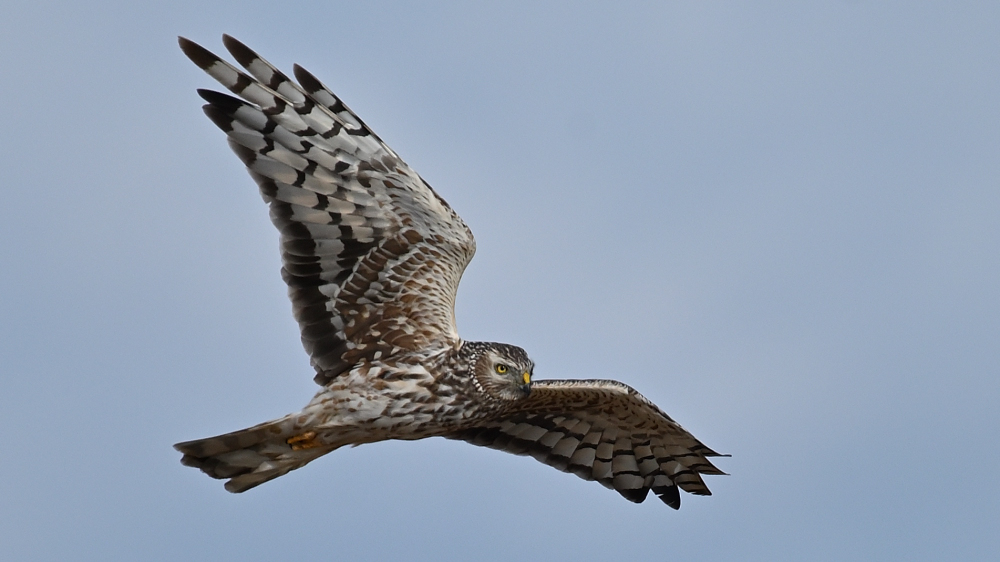
Den ene kom ganske tæt forbi observationsbusken i rigtig godt sollys. Den anden så vi på marken med et større bytte, som den flyttede længere ind i området i flere tempi, før den begyndte at æde, men kort efter mistede morgenmaden til en større kragefugl. Derefter så vi den først jage lidt i området igen, før den trak ud over havet ad et af de sædvanlige ’kærhøgespor’ tæt forbi p-pladsen ved Odden.
Den faste Nøddekrige (Nucifraga caryocatactes) gennem flere uger så vi intet til denne mandag morgen, mens den tyske Brevdue fra søndag stadig fløj rundt og fouragerede lidt her og der i området. Det er sikkert ikke godt for karrieren som væddeløbsflyver; måske skulle den overveje et nyt liv som fri fugl.
Se alle dagens observationer fra Gedser Odde i DOFbasen.
Folk på fuglestationen: Chris Sharp, Ole Friis Larsen.
Fine flokke af ænder på årets første efterårsdag
The ringing:
A steady morning's ringing was enjoyed today. A good number of birds with a pleasing variety of species resulting at the close of nets in 65 birds of 12 species.
A Sedge Warbler was probably the most unusual catch of the day as few of these are caught here. This specimen was only the third of this autumns migration, a low number when compared to the figures for Lesser Whitethroat and Willow Warbler whose totals so far are into the two hundreds. As a person whose usual ringing site is in woodland where we catch very few warblers I'm finding it very interesting to catch such good numbers of warblers. Its a bit like doing a warbler refreshment course, particularly regarding ageing the birds. And all is one of the reasons I like coming here.
The Catch was:
Dunnock/Jernspurv 2/-; Redstart/Rødstjert 2/-; Sedge Warbler/Sivsanger 1/-; Icterine Warbler/Gulbug 3/-; Lesser Whitethroat/Gærdesanger 11/-; Whitethroat/Tornsanger 8/-; Garden Warbler 4/-; Blackcap/Munk 13/-; Chiffchaff/Gransanger 6/-; Willow Warbler 11/-; Spotted Flycatcher/Grå Fluesnapper 3/-
Total 65 all new.
Trækket på Odden: Årets første efterårsdag blev en fin oplevelse på landets sydligste punkt med pænt træk af fugle over havet, hvoraf mange nok vil fremhæve morgenens seks kjover, men også trækket af svømmeænder bød på et godt ryk. Desuden var der som sædvanlig i weekender på denne tid af året godt selskab af fuglefolk, blandt dem Louis A. Hansen og Michael Grell, som har vikarieret, mens undertegnede har været bortrejst. Også Jimmy Skat, som har været et kendt ansigt blandt observatørerne ved Gedser Odde gennem mange år, har taget en tørn med sensommerens registrering af trækket på nogle af de dage, der ellers ikke var blevet dækket.
Mens trækket af rovfugle stadig var bemærkelsesværdigt svagt, kom der søndag et smukt træk af vores mindste andeart, Krikand (Anas crecca), med næsten 500 fugle, og over 100 af de stornæbbede Skeænder (Spatula clypaeta). September er træktid for de såkaldte svømmeænder, og der er sikkert flere på vej. Vores kolleger ved Põõsaspea Neem i Estland talte søndag tæt på 1.200 Skeænder og lige under 1.000 Spidsænder (Anas acuta), som vi måtte nøjes med godt en håndfuld af. Ud over svømmeænderne havde vi søndag et godt antal dykænder i form af 600 Sortænder (Melanitta nigra). Dem vil der også komme flere af.
Blandt dagens 8 kjover kunne vi uden videre bestemme 6 til Almindelige Kjover (Stercorarius parasiticus), mens de to øvrige forekom mere terneagtigt lette i flugten og derfor måske var af den mindre art Lille Kjove (Stercorarius longicaudus), men på grund af afstand og modlys lod vi dem flyve som ubestemte Lille Kjove/Almindelig Kjove.

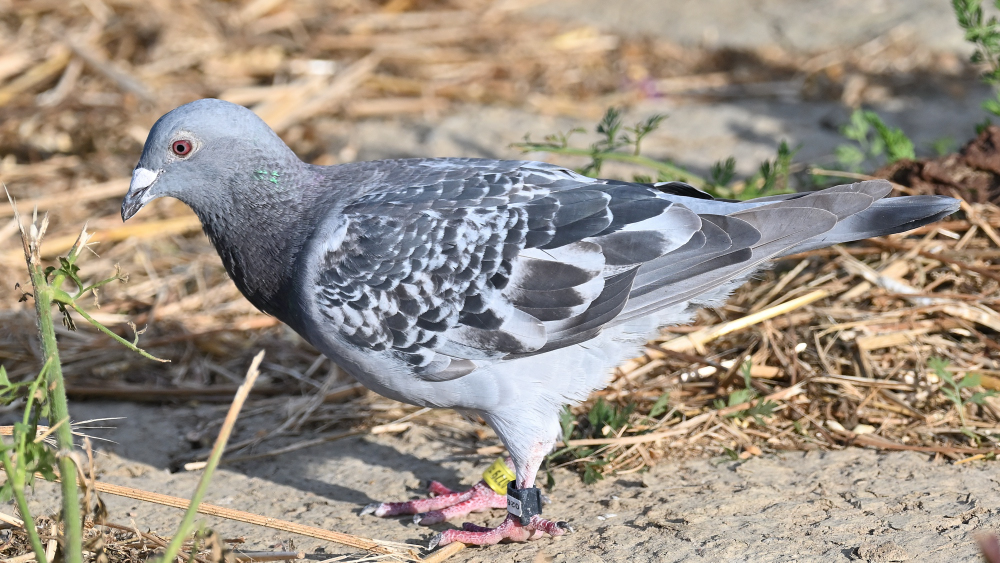
Se alle dagens observationer fra Gedser Odde i DOFbasen.
Folk på fuglestationen: Chris Sharp, Ole Friis Larsen.
